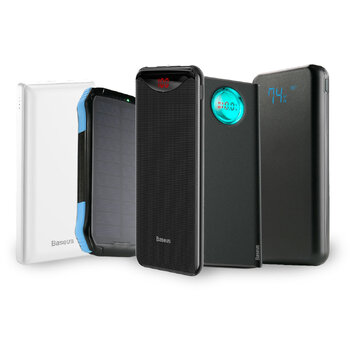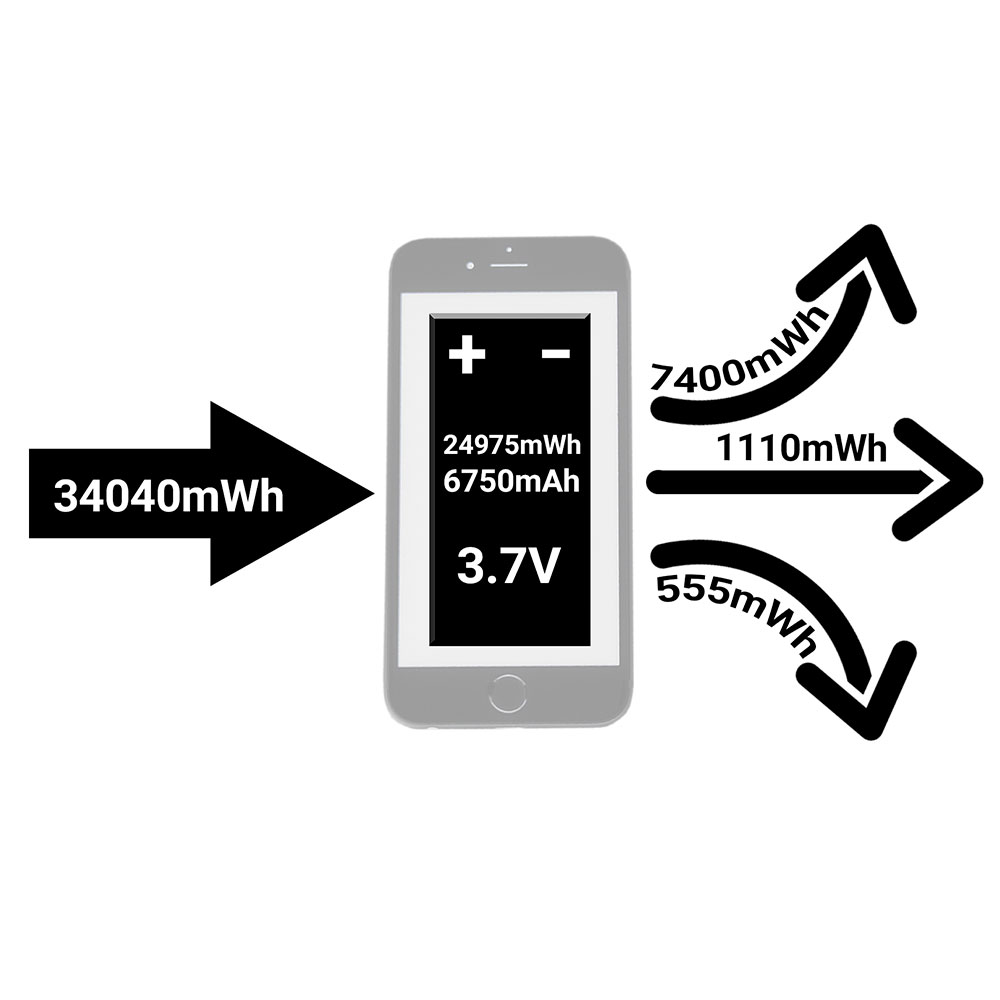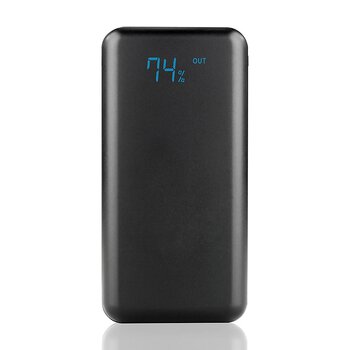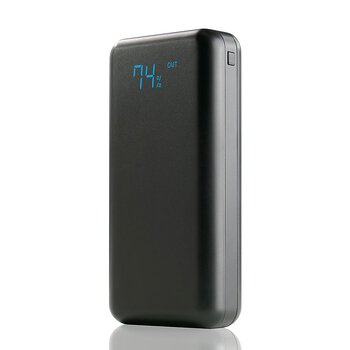- Tips
- technology
- Frequently Asked Questions
- Tests
- mAh capacity
- Rated Capacity
- everActive
- comparison
- Durability of rechargeable batteries
- Efficiency of rechargeable batteries
- battery voltage
- Accumulated energy
- Batteries vs rechargeable batteries
- LR03 AAA
- LR6 AA
- eneloop
- AG13 LR1154 LR44
- Delta V
- Charge Cycles
- internal resistance
- charge level
- CR 2032
- memory effect
- accredited test
- SR44 357
- Hearing Batteries 675
- SR626 377
- Watch Batteries
- Polarity
- Mah
- passivation
- LS 14250
- LS 14500
We choose PowerBank! How to compare the capacity and usability of your power bank? What does the capacity of a power bank really mean?

The basic and often the only parameter given by power bank manufacturers is the capacity of the batteries built into them
This is an obligatory requirement, as each manufacturer is obliged to provide the capacity of the built-in Li-ion battery when it is integrated in this type of device. This is required, for m.in, by regulations on safety in transport, in particular air transport.
So we buy a power bank with a built-in battery with a capacity of 10,000 mAh, while the battery in our mobile phone has 3,300 mAh. We are going on a several-day trip convinced that our power bank will allow us to fully charge our smartphone 3 times... Unfortunately, this will certainly not happen, even if we bought a reliable, proven everActive EB-L10K model with a guaranteed battery capacity of 10,000 mAh. Why?
How many times can you charge a phone with a 3300 mAh battery with a good 10000 mAh power bank?
The vast majority of power banks use a rechargeable battery or a lithium-ion Li-ion battery pack with a rated voltage of 3.7V.
In our case, the manufacturer declares the use of a 10,000 mAh battery in its powerbank. The value expressed in milliampere-hours [mAh] does not take into account the waveform of the voltage value during discharge, but only the time in which it drops to a set level, e.g. 3.0 V for a Li-ion battery.
For charging devices such as smartphones, tablets, etc. a USB port with a voltage of not less than 5V DC is used - this voltage is clearly higher than that of the battery in the power bank. Therefore, the voltage must be converted (increased). We will show you how you can easily estimate on your own what energy and usable capacity our powerbank will have for devices that require 5V for charging.
We need to calculate the value of energy available from the power bank
The capacitance value in mAh/Ah (milliampere-hours, ampere-hours) multiplied by the voltage V gives us the already estimated value of energy expressed in mWh/Wh (milliwatt-hours, watt-hours).
In the case of a 3.7V 10000 mAh Li-ion battery, we can easily calculate how much energy our power bank will theoretically have: 3.7V x 10000mAh = 37000 mWh. The energy value expressed in mWh or Wh (watt-hours) is usually quoted on the power bank in addition to the capacity in mAh.
A typical 10000 mAh power bank can therefore store 37000 mWh of energy. This value can already be converted into a unit of mAh capacity for any output voltage.
In ideal, lossless conversion conditions, with a voltage of 5V at the USB output, we have: 37000 mWh / 5V = 7400 mAh.
The result of 7400 mAh is the theoretical maximum that our powerbank with a built-in 10000 mAh / 3.7V battery could have at a 5V output. Even this value would no longer be enough to charge our smartphone with a 3300 mAh battery three times.
In addition, the voltage conversion that takes place in our powerbank brings some losses - the efficiency of the converter built into the powerbank is never 100%.


Another aspect is the efficiency of the devices
A few years ago, the typical efficiency of such devices did not exceed 80% (there were even models below 70%), which resulted in a result of 5920 mAh at the USB output (80% of 37000 mWh divided by 5V) obtained from a typical 10000 mAh / 37 Wh power bank.
In some newer devices, efficiency has improved significantly - currently the best power banks can boast an efficiency of 90% and higher for typical loads. At 90% efficiency, our power bank with a built-in 37000 mWh battery already has an effective power of 33300 mWh, which means that the 6660 mAh capacity is available to the user on the USB 5V output, which is over 12% more than a less efficient unit with the same capacity!
Our benchmark everActive EB-L10K power bank is even more efficient and offers an even better result under typical load, usually exceeding 6750 mAh on the USB 5V output, which is already 14% more than an equivalent device with 80% efficiency and the same capacity of the built-in battery.
The impact of Quick Charge technology on the efficiency of charging from a power bank
Even when using a highly effective power bank, we must be aware that the capacity obtained at the USB output will be even lower at a higher output voltage, when we use the Quick Charge technology - both when the power bank will work under full load, and when it will only be used to maintain the charge of another device (at a very low output current).
A more important parameter in this case is the typical efficiency of such a charger. Efficiency tells us how much accumulated energy expressed in the Wh/mWh unit we actually have at our disposal to charge our devices. Such efficiency is never 100%, but in the best devices the total energy available at the output of the powerbank is only slightly lower than that of the built-in battery - a good example is the aforementioned energy bank everActive EB-L10K, where the user has up to 34040 mWh of energy at his disposal at the 5V USB output, with a built-in 3.7V / 37000 mWh battery.

So how much of this energy and how many milliampere hours [mAh] will actually go to our phone and tablet battery?
There is no clear answer to this question, but we will try to explain it as well.
We must be aware that the entire process of charging mobile devices is already highly inefficient at its source.
As I have already written, our mobile devices, phones, tablets, webcams, cameras, etc. require a voltage of not less than 5V for charging, and they are usually powered by a battery with a nominal voltage of 3.7V. When using a power bank charger, we have two voltage conversions "on the way". In simple terms, it is a change from 3.7V to 5V (which we wrote about above), and then from 5V back to 3.7V.
The powerbank device is designed to transfer the energy available from the built-in 3.7V battery as efficiently as possible to one that is friendly to end devices - available from the 5V USB output. This is where the task of the powerbank ends, and the further process and efficiency of charging depends only on the device you have and the quality of the USB cable used.


As we explained earlier, in the case of a good power bank with a 10000 mAh / 37000 mWh battery, we can count on 6750 mAh / 34040 mWh available at the 5V output. Unfortunately, the process of charging a typical Li-ion battery, which is in our phone, is usually not very effective and as a result, a large part of this energy is lost, wasted - most often in the form of heat. These losses accumulate starting from the USB cable, connections, electronics in our phone, to the built-in Li-ion battery, which also does not charge losslessly even in ideal conditions. What kind of losses they are and what they depend on is a topic for a separate article, but they no longer depend on our power bank.
Ultimately, in simple devices, with typical charging systems, up to approx. 30% of the energy supplied by the powerbank is lost. In newer phones and tablets, the process is more effective and there we can count on a larger number of mAh delivered.
To sum up, a branded powerbank with a capacity of 10000 mAh will allow us to provide about 6700-8000 mAh to the battery in our final device - but only if our device has a 3.7V battery. The mAh value cannot be compared at different voltages (we can always compare the energy expressed in mWh/Wh/kWh) and so if our device had a 7.4V battery, the amount of mAh supplied to it would be half as much from the same powerbank.
To answer the question from the introduction - a good 10000 mAh power bank should charge our phone with a 3300 mAh / 3.7V battery at least twice. In addition, we could count on up to another 40% top-up, as long as the manufacturer of our phone took care of the high efficiency of the charging process.
When comparing power banks with each other, it is not enough to compare their capacity, we should also compare their efficiency, or at least the usable capacity from the USB output, if the manufacturer provides it. In addition, we must be aware that regardless of the capabilities and efficiency of such a charger, quite a large part of the energy is unfortunately always wasted in our charged device.
As our article shows, comparing only the declared value of the battery capacity built into the power bank can be very misleading, especially since not all manufacturers reliably provide this parameter, overstating it on the label.
Author: Michał Seredziński
Copying the content of the text or its part without the consent of a representative of Baltrade sp. z o.o. is prohibited.
Power banks available in the hurt.com.pl store
Power Bank (powerbank) everActive Energy Bank EB-L20k 20000 mAh
high-quality lithium polymer battery
iQ Smart Charging technology - built-in advanced chip automatically detects the connected device and charges it with the maximum current suitable for it
high performance - fast charging of 2 devices at once
output: 2 x USB DC 5V / 2A max.
Input: 1 x micro USB DC 5V / 2A
Input: 1 x USB-C DC 5V / 2A
clear LED display
capacity 20000mAh - guaranteed
compact powerbank dimensions and light weight of 416g
-
Bardzo pomocny artykuł, dziękuję uprzejmie!
-
No to teraz wiem o co kamon... a już myślałem że moje powerbanki są oszukane :|)

